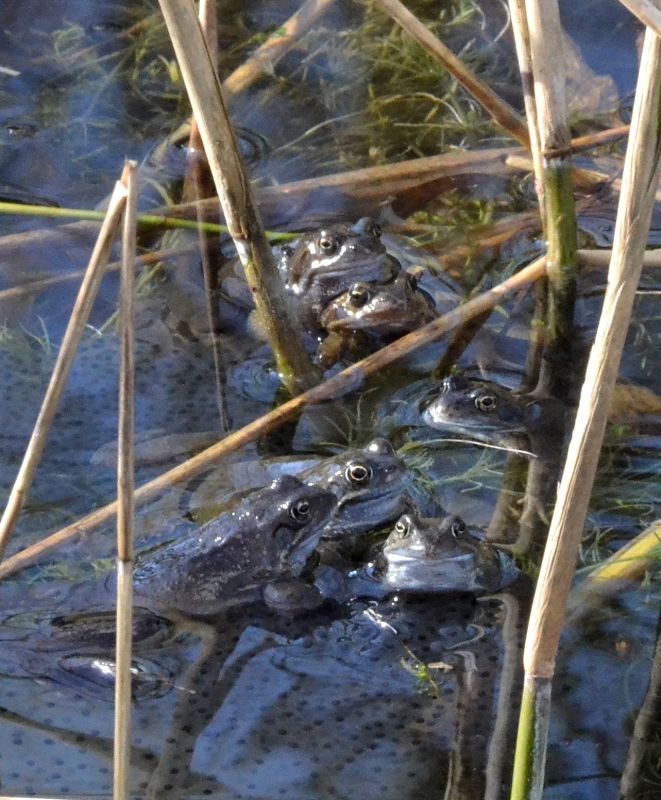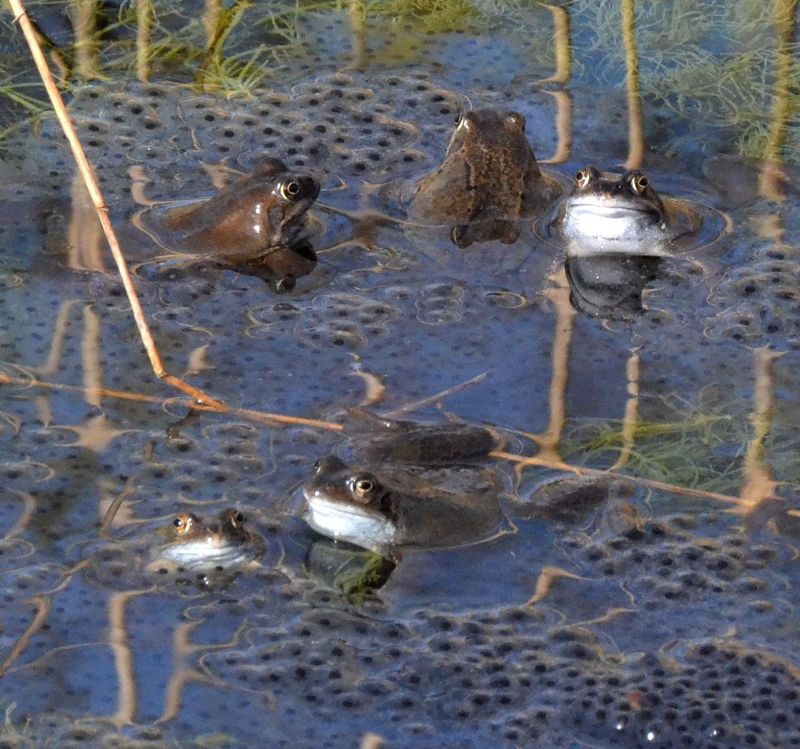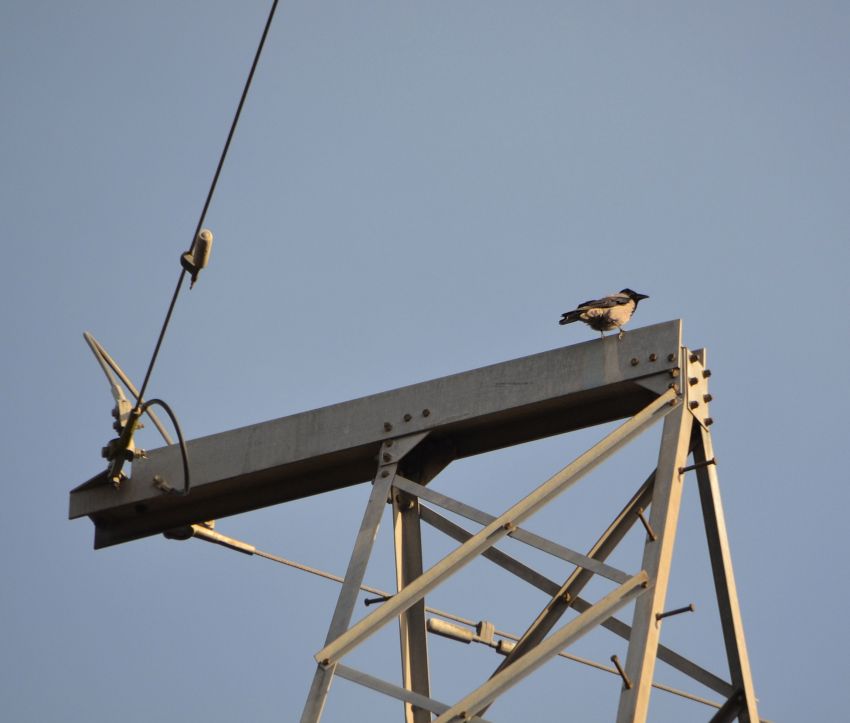This seems like an appropriate way to reflect the imminent onset of spring. The awakening of frogs from hibernation and appearance of spawn in ponds and slow-moving streams are classic indicators of the changing season. It typically occurs during February, continuing into March with a three week cycle before tadpoles hatch. Shadier and partially reed-filled ponds are especially favoured by larger assemblies of the breeding amphibians.
I have long had a partiality for frogs, a non-bird or insect wildlife group I especially enjoyed recording abroad during my pre-Covid ramblings of the previous decade. So when Ewan featured a mass mating at a site in Oxford on his own blog (see here) a year ago I resolved to experience the spectacle for myself this season. And after pictures appeared on another Oxon wildlife blog a few days ago I went to take a look this morning.
I will admit that my previous experience of the humble British Common Frog (Rana temporaria) is largely confined to those that occur in my garden each year, typically leaping out to startle me from one hidden place or another in late summer and autumn. Since I do not live close to flowing or standing water I must assume these are immatures that have dispersed from hatching sites such as I visited today. Now I have gained a much fuller understanding of our ubiquitous national frog.
Frogs mostly hibernate on land, finding underground places of concealment or secreting themselves in surface structures or piles of vegetation. Unlike mammals that pass winter in deep sleep, amphibians assume a period of low metabolic function and so may be active intermittently. Some males risk lying dormant or leading a slow-moving existence in larger ponds or those with an inflow, where potentially fatal freezing over is less likely. Hence they will be in place when the first new season females arrive. There they are joined by the large scale nocturnal migration of adult frogs that is prompted by rising temperatures as each spring approaches.
One such breeding site is Lye Valley LNR (see here) in Headington, north-east Oxford (SP547058). The wildlife-rich SSSI (pictured above) lies between the Churchill Hospital complex to the north-west and a mid-20th century housing estate on its other side. This is one of the best national examples of very rare “calcareous fen” habitat, a wet alkaline area fed by lime-rich natural springs along the valley walls. Owned by Oxford City Council, it is wonderfully well maintained in partnership with BBOWT and volunteer groups, with a boardwalk running the length of the site to facilitate access.


I arrived there in the late morning today having arranged to meet Ewan on-site. The breeding frog pools (above left) lie in the central stretch of the valley and just two more observers were present. My first comment was “No frogs”, but one of the others then spotted movement. Getting my eye in I became aware of masses of frogspawn in the pool we overlooked. Ewan was next to arrive and things soon livened up as presumably the water temperature rose. Before long we counted around 20 adult Common Frog all active amongst reedy habitat in the centre of the pond, the males commencing to sing in chorus.


My immediate impressions were how much larger these were than the frogs I am used to seeing in my garden, and also the different colour forms. According to Collins field guide adults may be up to 11cm in length. Some of the biggest females today seemed quite bloated, presumably with spawn and often with more than one male in attendance. Females are stouter in build than males, being shorter in the body and longer in the legs. The hind legs in both genders are one and a half times the length of the head and body combined, as shown in the bottom row studies below.




These images from today match the illustration in Collins. Breeding males appeared grey-toned with a bluish throat, while the larger, plump females are reddish brown with pearly white warts on their flanks. But the ground colour of the Common Frog is actually very variable. The upper parts may be grey, olive, yellow, brown, orange or red; and this may be speckled, spotted or marbled with brown, red or black. The variably speckled underparts are dirty-white to pale yellow in males and yellow to orange in females. In the breeding season males’ skin becomes slimier and the warty granules on females’ skin enlarge.
My research further reveals there is a marked tendency for individuals’ colouring to alter from light to dark according to the surroundings, as the pigment cells of the skin can expand and contract in response to varying intensities of reflected light. I have included all this detail here as the immature Common Frogs of my previous experience had always appeared pretty much alike to me, but not so in adults so it seems.
There is no courtship ritual. Males in a breeding pond will clasp competitively the nearest female around the body and lie on her back in an embrace known as “amplexus”. The females then shed one or two clumps of spawn which is fertilised by the coupled male, though in the above picture things appear to be the other way round. Unmated males will also inject sperm into the proceedings to help things along. The most prolific females can produce up to 4500 eggs, deposited over vegetation in shallow water and often forming a continuous floating carpet with the spawn of other females.
My experience today was much like butterflying in any publicised location, in that finding something means other people will home in and restrict my picture taking space. It being a sunny Saturday morning we were soon surrounded by mums and kids, the young children taking a keen interest in the “froggies” and displaying an encouraging wildlife awareness. All Covid restrictions were lifted in Great Britain a few days previously, which is something I agree with and welcome, but the situation in this next picture still seemed strange.
One lady and her daughter then walked away and I noticed them stop and point into the next pond, so taking the opportunity for a bit more elbow space I followed. I had checked that one not long previously but now it’s surface had suddenly erupted with many more partially submerged frogs (pictured below) than the first pond contained. To my untrained eye these looked smaller than that 20-strong group in what I suppose might be the “master pond”. And all the while the dull, rasping “grook … grook … grook” male chorus filled the air, augmented by the atmospheric grunts and chirps of the females.
After spawning such mass assemblies of Common Frog disperse into the countryside, or in this case suburban Oxford possibly for up to several kilometres. As I now realise, individuals take three years to fully mature and may live for up to ten years. The species occurs almost everywhere in the British Isles, and western Europe other than the Iberian peninsula, Italy and the Balkans; typically inhabiting damp places and undergrowth. I had not witnessed their breeding spectacle before and so was pleased to have done so now.
This annual event here today appeared to be common knowledge amongst local people. Leaving the site in the early afternoon I was passed in the opposite direction by children carrying pond dipping nets. The public is asked not to remove frogspawn, since the alternate location to which it is transferred may not suit and doing so can spread disease affecting other wildlife. Visitors to Lye Valley LNR are also requested to keep to the boardwalk and not enter the sensitive and unique habitat of this beguiling urban oasis.















